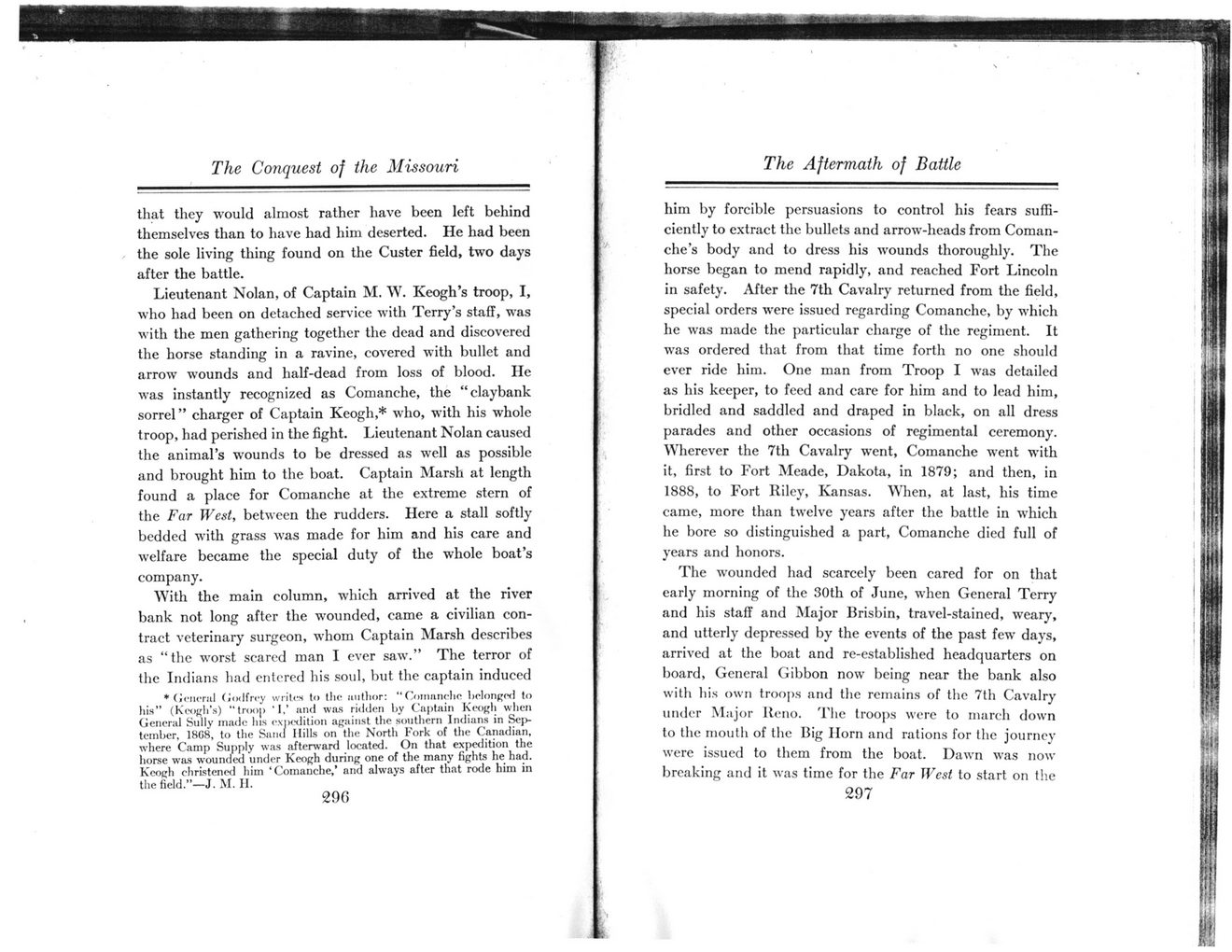This text was obtained via automated optical character recognition.
It has not been edited and may therefore contain several errors.
The Conquest of the Missouri that they would almost rather have been left behind themselves than to have had him deserted. He had been the sole living thing found on the Custer field, two days after the battle. Lieutenant Nolan, of Captain M. W. Keogh?s troop, I, who had been on detached service with Terry?s staff, was with the men gathering together the dead and discovered the horse standing in a ravine, covered with bullet and arrow w'ounds and half-dead from loss of blood. He was instantly recognized as Comanche, the ?claybank sorrel? charger of Captain Keogh,* who, with his whole troop, had perished in the fight. Lieutenant Nolan caused the animal?s wounds to be dressed as well as possible and brought him to the boat. Captain Marsh at length found a place for Comanche at the extreme stern of the Far West, between the rudders. Here a stall softly bedded with grass was made for him and his care and welfare became the special duty of the whole boat s company. With the main column, which arrived at the river bank not long after the wounded, came a civilian contract veterinary surgeon, whom Captain Marsh describes as ?the worst scared man I ever saw.? The terror of the Indians had entered his soul, but the captain induced * General (iodfrey writes to the author: ? Comanche belonged to his? (Keogh?s) "troop ?I,? and was ridden by Captain Keogh when General Sully made his expedition against the southern Indians in Sej>-teinber, 18G8, to the Sand Hills on the North Fork of the Canadian, where Camp Supply was afterward located. On that expedition the horse was wounded under Keogh during one of the many fights he had. Keogh christened him ?Comanche/ anu always after that rode him in the field.??J. M. II. 290 The Aftermath of Battle him by forcible persuasions to control his fears sufficiently to extract the bullets and arrow-heads from Comanche?s body and to dress his wounds thoroughly. The horse began to mend rapidly, and reached Fort Lincoln in safety. After the 7th Cavalry returned from the field, special orders were issued regarding Comanche, by which he was made the particular charge of the regiment. It was ordered that from that time forth no one should ever ride him. One man from Troop I was detailed as his keeper, to feed and care for him and to lead him, bridled and saddled and draped in black, on all dress parades and other occasions of regimental ceremony. Wherever the 7th Cavalry went, Comanche went with it, first to Fort Meade, Dakota, in 1879; and then, in 1888, to Fort Riley, Kansas. When, at last, his time came, more than twelve years after the battle in which he bore so distinguished a part, Comanche died full of years and honors. The wounded had scarcely been cared for on that early morning of the 30th of June, when General Terry and his staff and Major Brisbin, travel-stained, weary, and utterly depressed by the events of the past few days, arrived at the boat and re-established headquarters on board, General Gibbon now being near the bank also with his own troops and the remains of the 7th Cavalry under Major Reno. The troops were to inarch down to the mouth of the Big Ilorn and rations for the journey were issued to them from the boat. Dawn was now breaking and it was time for the Far West to start on the 297

Williams, Dr John W Conquest-of-the-Missouri-11